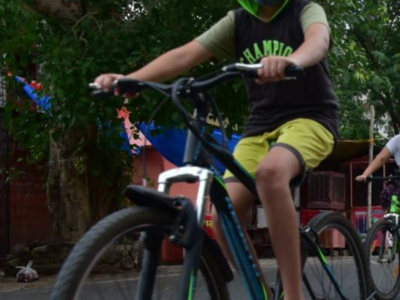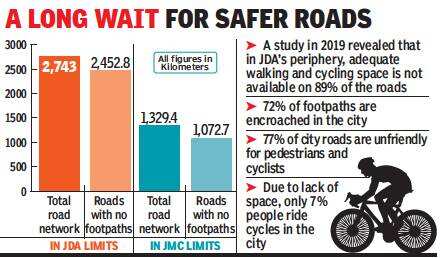
JAIPUR: With majority of the city roads encroached and vehicular traffic increasing, earmarking a dedicated cycle corridor for safe movement remains a challenge for city planners.
The civic agencies, including Jaipur Smart City Limited (JSCL), are promoting cycling, but in absence of space on many major roads, providing a safe passage will be a difficult task after traffic resumes completely, post Covid.

At present, in the absence of safe passage, only 7% people ride cycle in the city. However, as per the National Urban Transport Policy, the city traffic should comprise 31% cyclists and pedestrians.
A senior town planner said, in street design guidelines, pedestrians and cyclists have a top share on the road. After this, public transport should be given priority. A person driving a car should be given the least importance. “In Jaipur, the entire right of way is reserved for automobiles and on majority of city roads there is no space. On a 9-metre road, 4.5 metres should be dedicated to cyclists and pedestrians. However, the entire corridor is utilised for vehicle movement or parking,” he said.
Experts believe, in an ideal situation, city roads should have elevated lane made of a synthetic track that would be three to four inches above the road to give the cyclist a smooth ride. The practice has been followed across the world to separate cycle track from transport corridor. As laying synthetic track is an expensive affair, the roads can be merged with footpath to provide safe passage. However, a recent study conducted by JDA revealed 72% of footpaths are encroached in the city.
A senior JDA engineer said, “Around 77% of city roads are unfriendly for pedestrians and cyclists. Vehicles are parked on the footpaths in violation of the National Urban Transport Policy. According to the Indian Roads Congress, all roads which have pedestrian traffic are supposed to have a footpath with a minimum width of 1.5 metres and cycle track with 2 metres.”
Sources said, in a study which was concluded in 2019, revealed that in JDA’s periphery, adequate walking and cycle space is not available on 89% of the roads.
“In the total 2,743km road network, footpaths are not available on 2,452.8km in JDA periphery,” said a source. The situation is the same on roads falling under the JMC periphery as out of total 1,329.4km road length, footpaths are not available on 1,072.7km area, which is approximately 81%.
The civic agencies, including Jaipur Smart City Limited (JSCL), are promoting cycling, but in absence of space on many major roads, providing a safe passage will be a difficult task after traffic resumes completely, post Covid.

At present, in the absence of safe passage, only 7% people ride cycle in the city. However, as per the National Urban Transport Policy, the city traffic should comprise 31% cyclists and pedestrians.
A senior town planner said, in street design guidelines, pedestrians and cyclists have a top share on the road. After this, public transport should be given priority. A person driving a car should be given the least importance. “In Jaipur, the entire right of way is reserved for automobiles and on majority of city roads there is no space. On a 9-metre road, 4.5 metres should be dedicated to cyclists and pedestrians. However, the entire corridor is utilised for vehicle movement or parking,” he said.
Experts believe, in an ideal situation, city roads should have elevated lane made of a synthetic track that would be three to four inches above the road to give the cyclist a smooth ride. The practice has been followed across the world to separate cycle track from transport corridor. As laying synthetic track is an expensive affair, the roads can be merged with footpath to provide safe passage. However, a recent study conducted by JDA revealed 72% of footpaths are encroached in the city.
A senior JDA engineer said, “Around 77% of city roads are unfriendly for pedestrians and cyclists. Vehicles are parked on the footpaths in violation of the National Urban Transport Policy. According to the Indian Roads Congress, all roads which have pedestrian traffic are supposed to have a footpath with a minimum width of 1.5 metres and cycle track with 2 metres.”
Sources said, in a study which was concluded in 2019, revealed that in JDA’s periphery, adequate walking and cycle space is not available on 89% of the roads.
“In the total 2,743km road network, footpaths are not available on 2,452.8km in JDA periphery,” said a source. The situation is the same on roads falling under the JMC periphery as out of total 1,329.4km road length, footpaths are not available on 1,072.7km area, which is approximately 81%.

Coronavirus outbreak
Trending Topics
LATEST VIDEOS
City
 On cam: 12-year-old risks life to save drowning man twice his age in Nainital
On cam: 12-year-old risks life to save drowning man twice his age in Nainital  Shocking: UP BJP leader shot dead during morning walk in Baghpat
Shocking: UP BJP leader shot dead during morning walk in Baghpat  Shocking: 33-year-old man dials 100, issues threat for PM Narendra Modi, arrested by Noida police
Shocking: 33-year-old man dials 100, issues threat for PM Narendra Modi, arrested by Noida police  Peace and brotherhood will remain in Congress party: Rajasthan CM Ashok Gehlot
Peace and brotherhood will remain in Congress party: Rajasthan CM Ashok Gehlot
More from TOI
Navbharat Times
Featured Today in Travel
Quick Links
Kerala Coronavirus Helpline NumberHaryana Coronavirus Helpline NumberUP Coronavirus Helpline NumberBareilly NewsBhopal NewsCoronavirus in DelhiCoronavirus in HyderabadCoronavirus in IndiaCoronavirus symptomsCoronavirusRajasthan Coronavirus Helpline NumberAditya ThackerayShiv SenaFire in MumbaiAP Coronavirus Helpline NumberArvind KejriwalJammu Kashmir Coronavirus Helpline NumberSrinagar encounter
Get the app




